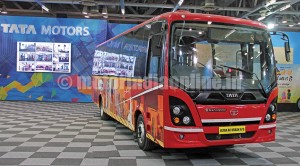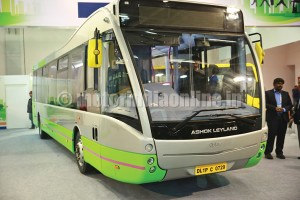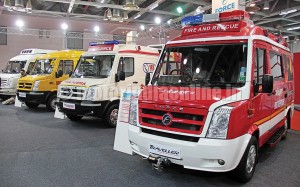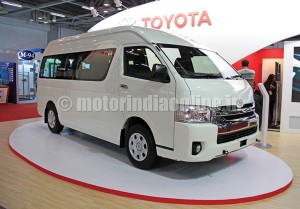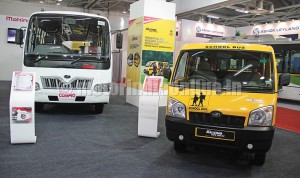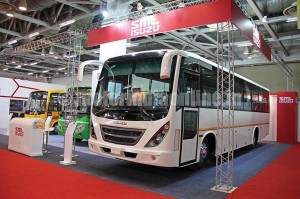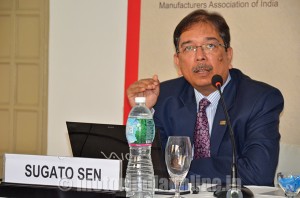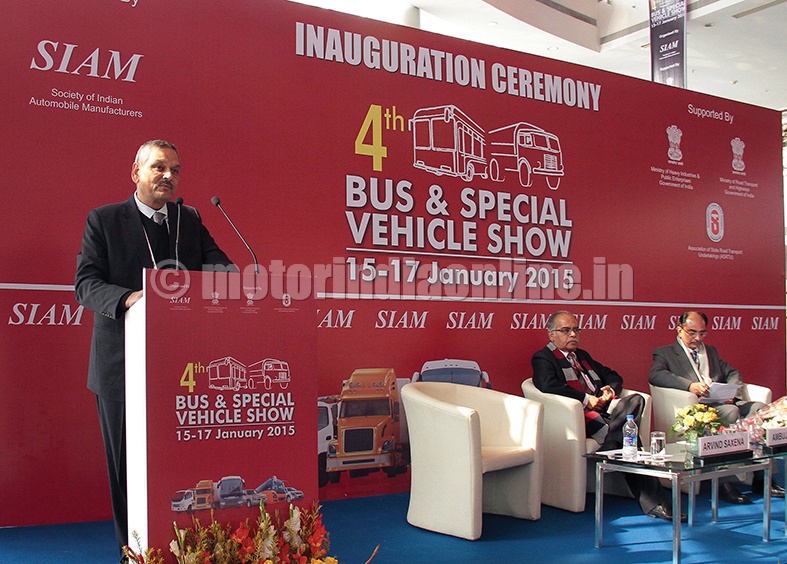
The 4th edition of the SIAM Bus and Special Vehicle Show, held at the India Expo Mart, Greater Noida, during January 15-17, turned out to be a grand success. The event showcased some of the major innovations and futuristic technologies in the automotive industry. The spirited show of the commercial vehicles industry got a major push with the announcement by Mr. Ambuj Sharma, Additional Secretary, Ministry of Heavy Industries, of the Government, earmarking Rs. 1,000 crores for the National Electric Mobility Mission Plan over the next two fiscal years.
Mr. Nitin Gadkari, Minister of Road Transport and Highways, was quite enthusiastic about the show and took out time to visit the stalls of all the exhibitors, and said it was quite encouraging to see the industry grow on the expected lines with the adequate support from the Government.
Mr. Vishnu Mathur, SIAM Director General, said: “It is a privilege to have been able to provide the manufacturers a platform to interact with the stakeholders. We believe that we have made adequate progress since the previous edition. We are really thankful to the exhibitors and the people who participated in the show.”
We take a look at the main highlights of some of the key exhibitors at the show.
Tata Motors
The company launched ‘Tata Skoolman’, a telematics based tracking solution, aimed at addressing pressing concerns over student safety during school bus travel. Tata Skoolman will be a standard fitment on the Tata Ultra range of school buses and will also be available for fitment on other models of school buses in the after-market. Taking the initiative of school bus safety forward, Tata Motors also launched the all new ‘Ultra BS3 – Safe School Bus’, equipped with Tata Skoolman.
Besides providing a host of safety features, Tata Skoolman makes it convenient for parents to track the arrival and departure of their children in real time (through SMS alerts), live tracking on a map or via a mobile phone application. It also provides an effective fleet management tool for schools/bus fleet operators to plan bus routes better and manage their school bus fleet more effectively.
Commenting on the occasion, Mr. R. Ramakrishnan, Senior Vice President, Commercial Vehicles Business Unit, Tata Motors, said: “Safety of children is of paramount importance to Tata Motors as it is to parents who entrust them in the hands of schools every day. In our endeavour to make School transit safer, Tata Motors are proud to announce the launch of the Tata Skoolman telematics system and the Tata Ultra Safe School Bus here. We are confident that these products will represent a giant step towards ensuring safe transit for school children.”
Tata Motors also showcased a range of their commercial vehicle products, including the Ultra Midi 900 mm ac, Ultra BS4, Ultra BS-III – safe school bus, 1512 luxury vehicle, Winger DICOR BS4 and 3L BS4 engine display.
Ashok Leyland
The company unveiled its first zero emission electric bus, Optare Versa EV. Ideal for feeder, airport tarmac and intra-city applications, the low-floor electric bus minimises the environmental impact, including zero emissions and zero noise; whilst matching the performance of a diesel vehicle. With its low-weight integral structure, Versa EV can accommodate up to 44 seats, optimising seating without consequent compromises in fuel efficiency and manoeuvrability. Available in lengths of 9.7m, 10.4m, 11.1m and 11.8m, the vehicle remains agile on rough roads.
“With increased awareness and sensitivity around environment safety and carbon footprints, the timing for the introduction of an electric bus is optimal. Versa EV is ideally placed to help deliver on our Government’s commitment to make urban transport efficient and reduce our country’s carbon footprint. We are one of the largest providers of electric and hybrid buses in the world, and today we are proud to bring this to India to help the country move up the path of efficient, comfortable, responsible and sustainable urban transport,” said Mr. T. Venkataraman, Sr. Vice President, Global Buses, Ashok Leyland.
The company also presented the 12m FESLF CNG (front-engine, semi low-floor, compressed natural gas) and the MiTR school bus at the SIAM show.
Force Motors
Force Motors showcased its new Traveller school bus at the show. The range of “No Tension” school buses offered by Force Motors starts from the 13-seater Trax Cruiser to the 26-seater Traveller 26. The school buses are now available across the country with the innovative “Child Bus Tracker” (CBT) facility as an option. The CBT is a feature aimed at enhancing the safety of school children. It gives parents, school administrators and operators option to track movement of the bus, get boarding and de-boarding alerts, and also get real time alerts on route deviation. It is also equipped with a RFID scanner which sends alerts when a child boards an incorrect bus and enables the school authorities to initiate immediate corrective actions.
The top-end version of CBT includes cameras that can stream live videos of the bus interiors to parents, school administrators and school bus contractors ensuring much needed peace of mind. The Force School buses meet the latest child safety regulations and are truly “No Tension” school buses. The Force Motors School Buses are available nationally at the dealerships and the prices range from Rs. 6.20 lakhs for the 13+ D Trax Cruiser to Rs. 12.40 lakhs for the Traveller 26 CNG (ex-showroom Delhi). Diesel as well CNG versions are available for both. Also on display were the new Super Luxury 15 seater Traveller, an Emergency Fire Tender cum Rescue Vehicle built on the Traveller platform and the Extreme Off-Roader Gurkha.
The Super Luxury Traveller is built on the wider Traveller 26 platform with air suspension offered for the first time in this category. It is ideal for 5 star hotel guest movement and inter-city luxury travel. It has extra wide 2×1 luxurious reclining seats, side sliding aisle seats for class leading elbow room. This vehicle comes with factory fitted air conditioning with individual air vents and stuck glass on sides and rear for great aesthetics and reduced NVH.
Continuing its foray into the “First Response” vehicles segment, Force Motors showcased its Emergency Rescue Vehicle, which follows the Advance Life Saving (ALS) Traveller Ambulances deployed by various state Governments. It is equipped with hydraulically operated cutters, spreaders, Metal and Wood chain saws, ladders, telescopic light masts, etc. critical for rescue and disaster management. Owing to its short 3050mm wheel-base it is extremely manoeuvrable unlike the huge disaster response vehicles built on big truck platforms, which are difficult to operate in the densely populated urban areas and congested traffic conditions.
The Force Motors school buses are available nationally at the dealerships, and the prices range from Rs. 6.20 lakhs for the 13+ D Trax Cruiser to Rs. 12.40 lakhs for the Traveller 26 CNG (ex-showroom Delhi). Diesel as well CNG versions are available for both. Also on display were the new Super Luxury 15 seater Traveller, an Emergency Fire Tender cum Rescue Vehicle built on the Traveller platform and the Extreme Off-Roader Gurkha.
Toyota Kirloskar Motor
Toyota Kirloskar Motor gave a sneak peek of its soon-to-be-launched new luxurious commuter vehicle, Hiace, at the show. First displayed at the 12th Auto Expo last year, the Toyota Hiace is acclaimed as a globally essential vehicle known for its impeccable reliability, refined space and durability.
The Hiace is an evolved product which offers robust flexibility along with superior comfort in inter and intra city travels. The Hiace is equipped with the famous Toyota D4 -D engine and a 4-speed automatic transmission which ensures a hassle free drive for long distances, over the years. In addition to adhering Toyota’s strict performance and quality requirements, specific standards have been established for the Hiace to ensure reliability and durability under the harshest conditions.
Regarded as the epitome of Toyota’s globally renowned “Quality Durability Reliability” across the globe, the Hiace is sold in more than 140 countries in the world. The Hiace has been developed to withstand various climates, roads, and usage conditions. It comes with a seating capacity for 10 passengers (including driver) in a configuration of 4 rows and an ample luggage space.
Speaking on the occasion, Mr. N. Raja, Director & Senior Vice President (Sales & Marketing), Toyota Kirloskar Motor Pvt. Ltd., noted: “We have been continuously studying the market for customer preferences and thus based on customer needs we are showcasing the Toyota Hiace – a product with premium features at the 4th Bus and Special Vehicle Show. The Hiace is sold in 140 countries and has clocked sales of around 6 million units across the world. We are showcasing the Hiace for our potential business customers. The Hiace will be the first of its kind offering from Toyota in India. Like all other Toyota vehicles, the Hiace is equally designed to provide unparalleled satisfaction in terms of comfort and safety”.
General Motors
The company had on display the Chevrolet Enjoy ‘Luxury Edition’, which is aimed at those who want an exclusive and luxurious MPV experience.
Other key participants include Isuzu Motors, which showcased a mobile service vehicle; Mahindra & Mahindra, which showcased a 40 Seater school bus (Touristercosmo BS4), a 40 Seater Staff bus (Touristercosmo BS3) and a Maxximo Mini School Van. While Renault showcased the Duster and Scala, SML Isuzu displayed three buses. Other exhibitors were Jupiter Face from ACGL, Bus Musuem, Articulated Bus – Long City Bus, Mitshubishi, which showcased a Pajero Sports. Allison Transmission, Hindustan Petroleum, Innova Rubbers, K B Autotech, Panasonic India, Sidhwal Technologies, AVL, Trans ACNR Solutions Pvt. Ltd. too showcased major technical breakthroughs achieved in their domains.
Other add-ons
The SIAM Bus and Special Vehicles Show also saw two major conferences in the form of the 2nd SIAM Automotive Logistics Conclave and a seminar on “Interactive Workshop on Upcoming New Technology in Buses”. The three-day theme for the conclave was “Multi Modal Solutions for Automotive Logistics”. The seminar on “Interactive Workshop on Upcoming New Technology in Buses” was organized by SIAM in association with the Association of State Road Transport Undertaking (ASRTU). The seminar was attended by the State Road Transport authorities.
The show saw visits from the managements of schools, colleges, hospitals, bus fleet owners and drivers to the various ministries in the government. The visits have generated significant number of queries from administrations of organizations like schools, colleges, hospitals and State Transport Authorities and Transporters.
Interview with Mr. Sugato Sen, Deputy Director General, SIAM
This is the 4th Bus and Special Vehicle Show in India. How has the response been this time? Has it met your expectations?
The response this time from both exhibitors and visitors was very good and encouraging. A lot of serious buyers were there to witness the latest technologies on display and the offerings from our OEMs. We are fairly satisfied with the response as this is the building years of the brand, and we expect this brand to grow and make a mark in the automotive events calendar in future. Moreover, this time we also had the privilege of taking around Mr. Nitin Gadkari, Minister for Road Transport & Highways, who visited the show and went around all the stalls. Senior Central Government and State Government officals from Delhi, Uttar Pradesh, Himachal, J&K, Rajasthan, Tamil Nadu, etc., also visited the show along with their teams. The visit of actual buyers from private bus operators fraternity, school managements, hospitals, tourism industry, etc., were also very encouraging.
What was the rationale behind incorporating special vehicles in the show? Was it to attract more OEMs?
Special vehicles can show what different forms a conventional vehicle can take. For instance, Force Motors came with a variety of vehicles and proved how a same vehicle can be utilised as bus as also as a fire & rescue vehicle, an ambulance, etc. Special vehicles also included modifications done to a passenger vehicle, or an alternative energy vehicle. Normally in a show like Auto Expo these vehicles do not get adequate attention, and we wanted to have focus on such efforts from companies so that they also get a proper platform for products display.
What is the size of the Indian bus industry and where does India stand in the global pecking order?
The Indian bus market is of the size of about 75-85 thousand vehicles per year, including big and small buses. As per statistics available with the world body of automobile manufacturers, India is ranked No. 2 behind China in terms of heavy bus production as of 2012.
Tell us about the prominence of special vehicles? Do they need special incentives? Do you have a market size attached to special vehicles in our country?
Special vehicles include those used as ambulance, fire extinguisher, rural commuting, off roaders, etc., on the one hand, and alternative energy vehicles on the other. These vehicles are for the good of the economy as well as the society. Not all special vehicles need incentives. However, they should not be discriminated against as in some cases in India. However, SIAM is of the opinion that due to problems arising out of poor economies of scale, the alternative energy vehicles should have special incentives in terms of tax relief and other support, at least till they become popular and the volumes become self-sustaining.
How are transport companies responding to the development of smart cites? How do you think the vehicle OEMs and other stakeholders can contribute to the smart city concept?
Development of smart cities would mean further development in inter- and intra-city transport system. No city can be classified as smart until it is planned and has a rapid public transport system. However, for the smart city concept to be successful we need to first supply the required infrastructure for a transport system. Public and private transport companies would both be interested in developing transport system in the upcoming smart cities.
OEMs have already supported development of public transport system in metro and other cities. They have also made available the right buses for last-mile connectivity from metro stations.
We need to clearly draw a roadmap for our smart cities, and OEMs, the Government and other stakeholders can then make it a success. The buses being manufactured now, are having the latest IT/ITES technologies from different manufacturers. They are GPS-enabled for tracking and course correction, CCTV fitted for monitoring the inside of the vehicles, and single-touch emergency alarms for any eventuality. As the smart city concept catches on, we are sure the industry will respond more with smarter vehicles.
How is the automotive industry performing at present? Most segments which were recession hit are coming out of it. How do you expect 2015 to be?
The automotive industry has had two years of slowdown in most of the vehicle segments. Some of the segments are now reviving. The expanded industry revival is largely dependent on economic revival. We are still expecting 2015 to be a good year for the industry. For buses, we expect a growth of slightly over 10 per cent in 2015-16.
The commercial vehicle segment growth is closely linked with that of the country’s economy. With clear signs of economic revival, do we also expect the CV segment to grow in the coming years?
Yes, the commercial vehicle segment is closely linked to the growth of the economy. Economic revival, specially in industrial production and mining activities, would help the CV segment bounce back. However, for the bus segment to do well, we have to make permits more easily available. Also, Government support to STUs needs to be augmented.
As the country’s apex body representing vehicle manufacturers, besides GST implementation, what are the other key issues/policy changes you expect from the Government in 2015 and the next couple of years?
The following are a few expectations we have from the Government:
* Reintroduction of the concessional excise duty on vehicles and auto components
* Rationalization of taxes on vehicles. Currently automobiles have four rates of excise duty
* Introduction of an incentive-based fleet modernization scheme to replace old, polluting vehicles with cleaner and more fuel-efficient ones
* Removal of NCCD from vehicles
* Revival in economic, industrial and mining activities
* Subsuming all taxes, including road tax, in GST
* Removal of excise duty anomaly on motor vehicles having carrying capacity of 10 to 13 persons, including the driver, which are currently levied a duty like a luxury cars.
* Two per cent CST to be reduced to one per cent as was proposed by the Government earlier.
* Excise duty on chassis of ambulance should be reduced
* Retain Customs tariff on CBUs for Cars/ MUVs/ Passenger 3-wheelers under Tariff Heading – 87.03 and Two-Wheelers/ Goods Three Wheelers under Tariff Heading – 87.11, while increase the custom tariff on Commercial Vehicles falling under Tariff Heading – 87.02 & 87.04 to 40%.
* Depreciation rate for motor cars, MUVs and vans other than those used in the business of hire, irrespective of the period of addition, should be raised to 25 per cent from 15 per cent.
* 150 per cent weighted deduction for expenditure incurred in skill development should be expanded to cover ITIs, and diploma and other similar institutes, including manufacturers’ own training institutes, from where the industry meets its skilled manpower requirement.
* Pilot projects on e-mobility should be implemented in consultation with the stakeholders. Funds may be earmarked for the purpose
